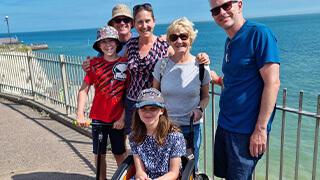breadcrumb navigation:
- Home /
- Research /
- Family stories /
-
current page
Naomi: epidermolysis bullosa simplex
Naomi: epidermolysis bullosa simplex
Published on
Updated:

Naomi story
Epidermolysis bullosa simplex
Naomi’s parents first noticed something was wrong when she was nine months old. She was crawling when they spotted blisters on the end of her fingers. Initially, they thought these were pressure marks from the floor, or perhaps a reaction to something she had touched. But the blisters kept growing, and it soon became clear that they were not going away. In just a few days they had swelled to become almost the size of her tiny fingers.
After being referred to a dermatologist and getting a blood test, Naomi was diagnosed with epidermolysis bullosa simplex (EBS), an extremely painful and debilitating genetic skin blistering condition.[1]
In terms of the daily challenges of living with EB, the temperature and the amount and type of activity can make a big difference to how Naomi feels. The family must make proactive choices about what she can and can’t do. For example, if she had a period of activity, such as walking on holiday or spending time doing an activity with her friends, she will pay the price for it in terms of blistering. “She’ll be in extreme pain, and she will need to take strong painkillers. We’ll be lancing and changing her dressings twice a day, and she’ll need to soak her feet. If we want to do anything as a family, it always needs to be wheelchair friendly as she will need to spend some time in her wheelchair – that is the reality,” says mum Carly.
Despite everything, Naomi is incredibly positive. She has a great circle of friends who look after her, sit with her indoors at school if she can’t do anything active outside, and push her around in her wheelchair.

“Physically, the pain is obvious, but there is a mental side to consider too. Naomi has told me that she finds it difficult to look at people whose feet don’t hurt, and she finds it difficult to accept that she can’t do everything that her friends do.”
“Over the years, we have met other EB families and people living with EB at the DEBRA (Butterfly skin charity) members’ events. It has helped so much to be able to speak with other people who have gone through the same challenges as us.”
Action Medical Research and DEBRA UK are proud to be jointly funding research at Queen Mary University of London which aims to improve understanding of the biology of epidermolysis bullosa simplex and look for potential drugs that can help improve skin repair. The research team led by Professor John Connelly hope this will lay the groundwork for the development of an effective new treatment that can help improve the outlook for affected children and their families.
Speaking of the prospect of more research, Carly hopes this could lead to new treatments or therapies for the EB community.
Prevention is key, as once the blisters come; you just cannot get rid of them. If we could reduce or stop the blisters coming that really could transform Naomi’s life and the lives of thousands of other children living with EB.
References
1. British Skin Foundation. Epidermolysis bullosa simplex. Available at: https://knowyourskin.britishskinfoundation.org.uk/condition/epidermolysis-bullosa-simplex/. [Last accessed March 2023].
This research is jointly funded by Action Medical Research and DEBRA UK – a charity and patient support group for people living with Epidermolysis Bullosa (EB).
